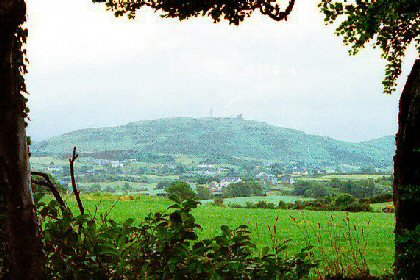It is often claimed that Saint Moninna was a sister of our patron saint Patrick.
It is unlikely. Perhaps the confusion rises from the common given name Darerca, since Patrick is also said to have had a sister of that name.
In his Confessio Patrick speaks of the number of converts made by him and his followers on their travels; he says that he does not know the number who ‘are born of our kind and generation’ .
Saint Moninna in Louth
In the historical context we should note that the term sister is used to identify faithful female followers. As such, Moninna was a sister, much as we today use this term to identify holy nuns. He alludes to a spiritual and not a familial generation. He would not have been ignorant of the number of children of his actual married sisters along with him. Remember that Patrick was first taken as a slave to Ireland. Saint Moninna’s father, Machta was prince of the Conaille of Muirthemhne, Louth and ruler of a territory stretching to the neighbourhood of Armagh. (Up to a millennium later this was Magennis land and once described as the Lordship of Glanconnell). Her mother, Coman was a daughter of a Northern king.
Moninna may in fact be a pet name, from the Irish and incorporating the possessive pronoun with an endearing suffix; perhaps Mo Bhlinne. This also explains why in the literature she is sometimes referred to as Saint Bline. In the Codex Salamanticensis (a folio of Lives of the Saints, formerly held in the Irish college in Salamanca, Spain) we read of the ‘Life of St Darerca or Moninna’.
One story tells how Saint Patrick when passing through the lands of Machta called with him and blessed his wife and little daughter and prophesied that one day her name would be long remembered in those lands. Since her years on earth are given as approximately 435-518 and Patrick died about 461, this is not impossible.
Saint Moninna made her first convent at Faughart (Bridget of Kildare and Faughart came the following (sixth) century). We do not know why she left this in the charge of a Saint Orbilla and retired a few miles north where she made the Convent of Cill Sleibhe Cuilinn or Church of Slieve Gullion. There is a folk story that there was some disagreement among her followers of what exact location to choose, some preferring an elevated site in the townland of Killian. While the debate raged a bell was heard ringing at Ballintemple intimating that it should be built there.
The Convent survived her death but its importance in later years must have been slight to judge from the rare allusions to it in the Irish Annals. Today the remains in the townland of Ballintemple are simply known as Killevy (church of the mountain) the distinctive name ending being omitted. Moninna’s saint day is celebrated on July 6.
The Convent of Saint Moninna became a monastery in the care of the Culdees, a brotherhood of men which it still was at its suppression under the Tudor monarch Henry VIII in the 1540s.
The church ruins now on the site comprise two distinct churches joined lengthwise. The smaller and older measures 16 yards by 8 yards and is characterised by a most impressive, low lintel doorway built of three massive shaped granite stones. The more recent church measures 24 yards by 8 yards and has a very impressive arched window with angel carvings still visible on its outside. It is unknown whether the seized buildings were used for worship by the few adherents of the Reformed Church of that time in this area.
Ironically the principal planter family Seaver was descended from a converted Catholic Nicholas Seaver of Lusk, County Dublin who moved here on his marriage to Elinor, daughter of Marmaduke Whitchurch who was given a royal grant of confiscated land. On his death in 1687 he was succeeded by a son Charles who married his cousin, Mary Powell. On his death in 1722 he was succeeded by Jonathan who became hereditary Sheriff of Co Armagh in 1748. His son Thomas, who built the family residence known as Heath Hall succeeded him two years later. In turn he was succeeded by the infamous Jonathan, ‘Seaver of the Bog’. He founded the Killevy Yeomanry – largely recruited from Eshwarry and Divernagh – that, along with that brutal Welsh regiment known as the Ancient Britons, ravaged and brutalised Irish and Catholic homesteads the length and breadth of South Armagh. Now buried in Meigh COI cemetery he died in 1841 at the age of eighty one years.
(Photo above was taken from Meigh COI cemetery looking south-eastwards towards Faughart).
